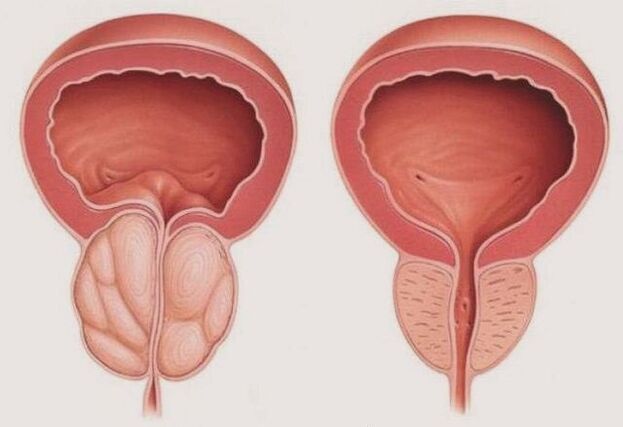Prostatitis is inflammation of the prostate gland. At present, urologists tend to think that prostatitis is not a single disease, but a combination of multiple diseases in the male genital area. This is one of the most common conditions of the male genitourinary tract, and according to experts, the proportion of men suffering from one or another form of prostatitis is growing. The risk of developing prostatitis increases with age.
Causes of Prostatitis
The immediate cause of prostatitis is two equally important factors. The first was a small pelvic congestion that turned out to be the prostate, and the second was an infection. In some cases, however, infectious agents cannot be detected in the prostate tissue, presumably in this case, the autoimmune process becomes the cause of prostatitis, which means that the prostate is attacked by the autoimmune cell system, due to its malfunctioning.
Predisposing factors for prostate inflammation are: infection, hypothermia, weakened immune system due to stress; hormonal imbalance, insufficiency of ejaculation, lack of exercise, food preferences (fried, fatty, smoked, spicy food addiction), urinary retention. Irregular sex is considered one of the common causes of prostatitis.
Types of Prostatitis
The International Classification of Prostatitis has been adopted, which is the most complete and covers all types of inflammation:
- the first sort. acute prostatitis;
- The second category. chronic bacterial prostatitis;
- The third category. Non-bacterial chronic prostatitis/chronic pelvic pain syndrome - a disease in which no infection has been detected for more than 3 months;
- Subclass III A. Chronic inflammatory pelvic pain syndrome (white blood cells identified in the secrets of the prostate);
- Subclass III B. Chronic non-inflammatory pelvic pain syndrome (no leukocytes in the secrets of the prostate);
- fourth category. Asymptomatic chronic prostatitis (leukocytes are present in the secretory of the prostate gland, the patient has no complaints, the disease was discovered incidentally).
- pain in the pelvic and genital area;
- Urinary system diseases, including slow urine flow, intermittent urine flow, incomplete bladder emptying, frequent urination, etc. ;
- Diseases of the genital area.
- Analysis of prostate secretion;
- digital rectal examination;
- Transrectal ultrasound of the prostate;
- Ultrasonography of the kidneys and bladder;
- blood test for PSA (prostate antigen);
- General blood analysis;
- General urinalysis;
- Urinalysis for urogenital infections before and after prostate massage;
- Uroflowmeter (urination test).
symptoms of prostatitis

The so-called "prostatitis triad" is the three most common symptoms of prostatitis. These include:
It is important to note that not all three symptoms of prostatitis are mandatory, and furthermore, acute and chronic prostatitis progress in different ways.
Symptoms of acute prostatitis: severe, severe pain in the rectum, perineum, testes, prostate area in the lower back; general deterioration, fever, headache and muscle pain, general weakness; difficulty urinating until acute urinary retention due to edema of the prostate and compression of the urethra.
Symptoms of chronic prostatitis: pain in the prostate area, but not as severe as acute prostatitis; urinary system diseases, sexual dysfunction: erectile dysfunction, short erection, accelerated ejaculation, etc. Chronic prostatitis can have an ups and downs course, with periods of exacerbation being replaced by periods of remission, or it can have persistent mild symptoms.
Unlike other inflammatory diseases, chronic prostatitis is often primary chronic when the chronic process is the result of untreated acute inflammation, when the patient himself finds it difficult to pinpoint the onset of the disease.
Diagnosis of Prostatitis
To diagnose prostatitis, the following studies were performed:
The main part of the diagnosis is to determine the cause of prostatitis, because the treatment depends on this. Another diagnostic challenge is ruling out prostate cancer.
treat prostatitis
Acute and chronic prostatitis of bacterial origin are treated with antibiotics. For acute prostatitis, large doses of antibiotics are prescribed even before bacterial culture results are available, because the acute course requires immediate action. In complex cases, anti-inflammatory non-steroidal drugs are prescribed, which also have analgesic effect.
Treatment of chronic prostatitis depends on the underlying cause. For non-bacterial prostatitis, take systemic strengthening, immunomodulatory drugs. The treatment of prostatitis is carried out with the mandatory participation of physiotherapy procedures: laser therapy, magnetic therapy, drug electrophoresis, ultrasound, etc.
Urologists say that medical treatment of prostatitis alone will only bring temporary relief, as it is ineffective without changing the usual lifestyle. To get rid of bad habits, to live an active life, to eliminate fatigue, to use special gymnastics to avoid stagnation of the small pelvis, to take less driving, to walk more, and to have enough rest.
It's also important to improve your sex life, make it regular, and eat well. Chronic prostatitis is prone to recurrence, so lifestyle changes should be permanent, and only in this case can prostatitis be cured completely.
Treating Prostatitis with Folk Remedies
For the treatment of prostatitis, folk methods have been widely and successfully applied, especially for the treatment of chronic prostatitis. They are milder than drugs, but still quite effective with fewer side effects, so folk remedies can be used for prostatitis long-term until symptoms of the disease subside.
From the point of view of folk remedies for prostatitis, herbal teas with anti-inflammatory and antibacterial properties are widely used: teas made from chamomile, sage leaves, calendula, etc. The herb is also used in the form of tinctures and balms. Honey and bee products are used as fortifiers. Beeswax is the perfect wrap for chronic prostatitis, an alternative to paraffin. Echinacea tincture is used as a mild immune stimulant; some varieties of honey have also been used successfully for the same purpose.





























